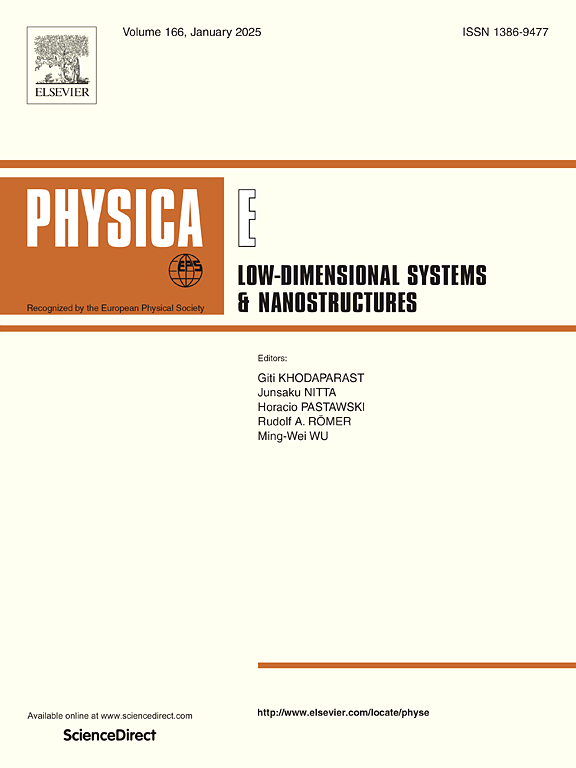Enhanced piezoelectricity induced by transition metal atoms adsorption on monolayer and bilayer MoS2
IF 2.9
3区 物理与天体物理
Q3 NANOSCIENCE & NANOTECHNOLOGY
Physica E-low-dimensional Systems & Nanostructures
Pub Date : 2024-11-06
DOI:10.1016/j.physe.2024.116148
引用次数: 0
Abstract
Piezoelectricity in MoS2 has attracted extensive attention because of potential applications in energy harvesting and sensors. However, the piezoelectricity of MoS2 monolayer is weaker than those of traditional piezoelectric materials. Here, based on first principles calculations, we report the large work function transition metal atoms (TMs = Ni, Pd, Pt and Ir) adsorbed on monolayer and bilayer MoS2 with large out-of-plane piezoelectric polarization. For TMs adsorbed on monolayer MoS2, the Ir and Ni adsorption exhibit stronger adsorption energy and larger migration barrier compared with Pd and Pt adsorption. All structures maintain dynamical stability at 300 K and exhibit p-type semiconducting band structures. The larger out-of-plane piezoelectric coefficients induced by adsorption increase with increasing the adsorption concentration, accompanied with slightly decreased in-plane piezoelectric coefficients, which is attributed to more and more electrons participating in redistribution along the out-of-plane direction. For TMs adsorbed bilayer MoS2, the energetically favorable configuration has same polarization orientation between two monolayers, which results in increased in-plane piezoelectric coefficients. The out-of-plane piezoelectric coefficients further increase due to the coupling of interlayer vertical polarization and TMs adsorption induced vertical polarization. Our results provide a possible way to increase the piezoelectricity of MoS2.
单层和双层 MoS2 上吸附过渡金属原子诱导的增强压电性
MoS2 的压电性因其在能量收集和传感器中的潜在应用而受到广泛关注。然而,与传统压电材料相比,MoS2 单层的压电性较弱。在此,我们基于第一性原理计算,报道了吸附在单层和双层 MoS2 上的大功函数过渡金属原子(TMs = Ni、Pd、Pt 和 Ir)具有较大的面外压电极化。对于吸附在单层 MoS2 上的 TMs,与吸附 Pd 和 Pt 相比,吸附 Ir 和 Ni 表现出更强的吸附能和更大的迁移势垒。所有结构在 300 K 时都能保持动态稳定,并表现出 p 型半导体带结构。吸附引起的面外压电系数随吸附浓度的增加而增大,同时面内压电系数略有下降,这是因为越来越多的电子沿面外方向参与了再分布。对于吸附了 TMs 的双层 MoS2,能量上有利的构型是两个单层之间具有相同的极化方向,从而导致面内压电系数增大。由于层间垂直极化和 TMs 吸附引起的垂直极化的耦合作用,面外压电系数进一步增加。我们的研究结果为提高 MoS2 的压电性提供了一种可能的方法。
本文章由计算机程序翻译,如有差异,请以英文原文为准。
求助全文
约1分钟内获得全文
求助全文
来源期刊
CiteScore
7.30
自引率
6.10%
发文量
356
审稿时长
65 days
期刊介绍:
Physica E: Low-dimensional systems and nanostructures contains papers and invited review articles on the fundamental and applied aspects of physics in low-dimensional electron systems, in semiconductor heterostructures, oxide interfaces, quantum wells and superlattices, quantum wires and dots, novel quantum states of matter such as topological insulators, and Weyl semimetals.
Both theoretical and experimental contributions are invited. Topics suitable for publication in this journal include spin related phenomena, optical and transport properties, many-body effects, integer and fractional quantum Hall effects, quantum spin Hall effect, single electron effects and devices, Majorana fermions, and other novel phenomena.
Keywords:
• topological insulators/superconductors, majorana fermions, Wyel semimetals;
• quantum and neuromorphic computing/quantum information physics and devices based on low dimensional systems;
• layered superconductivity, low dimensional systems with superconducting proximity effect;
• 2D materials such as transition metal dichalcogenides;
• oxide heterostructures including ZnO, SrTiO3 etc;
• carbon nanostructures (graphene, carbon nanotubes, diamond NV center, etc.)
• quantum wells and superlattices;
• quantum Hall effect, quantum spin Hall effect, quantum anomalous Hall effect;
• optical- and phonons-related phenomena;
• magnetic-semiconductor structures;
• charge/spin-, magnon-, skyrmion-, Cooper pair- and majorana fermion- transport and tunneling;
• ultra-fast nonlinear optical phenomena;
• novel devices and applications (such as high performance sensor, solar cell, etc);
• novel growth and fabrication techniques for nanostructures

 求助内容:
求助内容: 应助结果提醒方式:
应助结果提醒方式:


